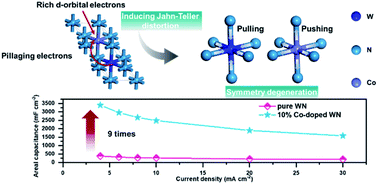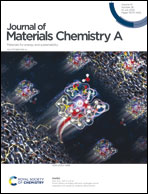Achieving extraordinary enhanced reversible capacitance through the synergy between octahedral structure and isovalent ionic doping†
Abstract
With excellent physico-chemical properties such as conducive crystal structures, pseudocapacitance, and metallic conductivity, tungsten nitride (WN) can be an attractive electrode material for supercapacitors but is restricted by its inferior intrinsic reaction activity. Herein, the energy harvestability of WN nanowires is significantly enhanced through a low-dose isovalent Co doping due to the synergistic effect between highly symmetric crystal octahedral structures and dopants. The difference in the number of d orbital electrons of Co3+ and W3+ can induce Jahn–Teller distortion in the local structure, enhancing the crystal/electron structure regulation ability. The Co dopants can capture electrons from W ions due to their lower electronegativity and act as highly active sites that participate in the energy storage process, improving the rate capability and reversible capacitance. When adopted as the electrode, the optimized Co-doped WN nanowires (Co-doped WN@CC, 3418.4 mF cm−2) can deliver a 9 times higher capacitance than the pure WN electrode (WN@CC, 379 mF cm−2) at 4 mA cm−2, and can steadily work for 10 000 continuous cycles. The full device that uses polypyrrole (PPy) as the counter electrode exhibits an intriguing energy density (108.33 μW h cm−2) at a high power density of 5.2 mW cm−2. Our work may inspire the development of rational cationic doping for advanced electrodes.



 Please wait while we load your content...
Please wait while we load your content...